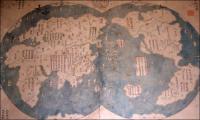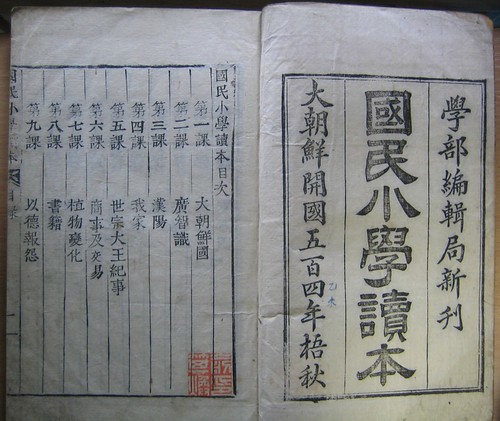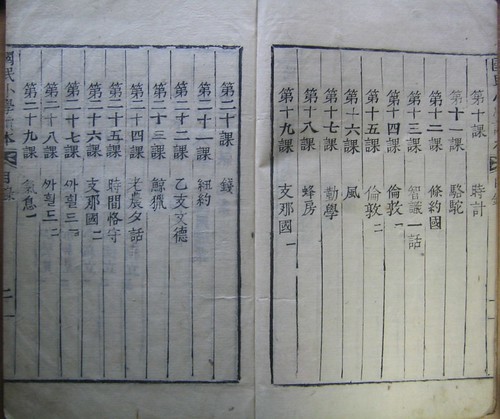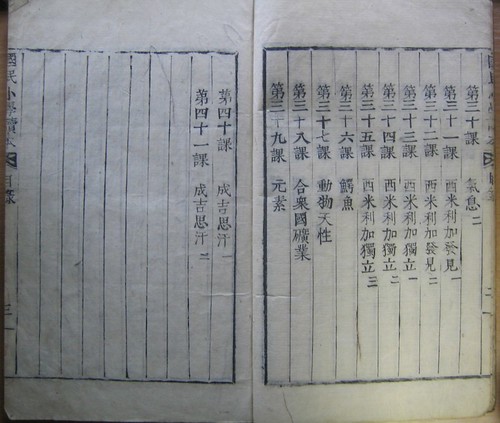Readers here might be interested in giving thoughts about a query and my comment regarding Yusin on the Korean Studies Discussion List by Dr. Alon Levkowitz.
His query: I would like to consult the group about a word – Yushin (Yusin). Was the term Yushin for the yushin constitution under Park’s regime was chosen for a specific goal. Does the word, without the problematic applications of the constitution by Park, means positive or negative?
Other comments:
Don Baker: I’m surprized that no one else on this list pointed out this time around that Park Chung-hee may have borrowed the word “Yusin” from the Japanese. The same two Chinese characters were used to characterize the “restoration” of imperial rule in Japan in 1868. Gari Ledyard pointed out in a message to this list in 2000 that Park may not necessarily have been imitating the Japanese, since those two characters have long been used in China in the positive sense of revitalizing reforms. However, given Park’s experience in the Japanese military, I’d be surprized if he were ignorant of that relatively recent Japanese use of that term. I suspect he used that term to show that he wanted to do with Korea what the Meiji oligarchs did with Japan, that is, turn it into a rich and powerful nation.
Ruediger Frank: on a side note, I was always struck by the similarities between the Saemaeul Undong (New Village Movement), evolving around the same time as the Yushin Constitution, and Mao’s Cultural Revolution. If you read some of Park Chung-hee’s speeches from that time, he stops short of talking about “the most beautiful characters” that could only be written “on a blank sheet of paper”, to paraphrase the Great Helmsman who wanted to erase all traces of old thought to make room for new thinking in the minds of his Chinese subjects. Park, too, emphasizes the alleged “backwardness” of Koreans and their attitudes and calls for a thorough
ideological modernization. Institutionalists such as Clarence E. Ayres would say that he tried to fight ceremonialism and supported technlogical dynamism. On a smaller scale, this is a process that repeats itself quite frequently in Korean politics until present time. The renaming of political parties, for example, is one expression of this continuous desire to “renew” or “revitalize”. The official slogan “Dynamic Korea” fits perfectly into this way of looking at the issue.
Another: I understand the meaning of “Yushin” under the umbrella of the revitalising reforms undertaken during the 70’s decade, meaning an increase of the heavy industry. The word itself does not entail negative, evenmore, it has a positive meaning: renewing, revitalising
Another: General Park Chung-hee introduced Yushin or the “Revitalizing Reform” system, which legitimized the authoritarian-led development. People were fed up with the Yushin system and student demonstrators in 1979 intensified in the latter half of the year with labour and student demonstrations in the Pusan and Masan areas which was later called the “Pu-Ma Uprising.” The Yushin system led to economic instability and unrest, which cumulated in Park’s assassination in October 1979. Park’s assassination led to calls by students and laborers for
the abolition of the Yushin system and direct elections. Such hopes were dashed when at the end of 1979 when General Chun Do-hwan and Roh Tae-Woo seized power from the interim government through a coup d’etat.
My comments:
I base comments on my current dissertation work that posits that South Korea’s response to a profound period of crisis between 1968 and 1972 led to a concerted program of national spiritual and material mobilization that created the modern South Korean and South Korea. One source I have consulted extensively is the diplomatic archives that only recently became available. I also conducted a close study of how this process operated in one local region, Kangwon province.
The term Yusin (I prefer the M-R spelling), as it relates to the Yusin Constitution (YC) (and this is the common understanding among scholars and the average South Korean), must be seen as a specific historical issue rather than in some generic way as suggested by Drs. Baker and Ruediger. It was a specific response to a specific circumstances of national crisis. Other studies have suggested a similar process at work in other nations – a deliberate effort to mobilize the nation’s physical and spiritual resources and restore/revitalize/renovate the nation in the face of profound internal and external crisis. Two quick examples spanning time and space: Lynn Hunt’s work on the French Revolution and Frederick Dickinson’s study of Japan’s response during WW I. The U.S. has gone through this process a number of times in its history, most recently and currently as result of 9/11 (President Bush’s emphasis on the moral dimension of America’s tasks and challenges is very much in synch with history’s examples).
When YC was instituted in 1972 it was done so as a response by Park (PCH) to a profound period of national crises, real and perceived, that began in early 1968. Internally and externally the world order and the desired course of internal development upon which PCH based his long range plans for nation building all seemed to crumble. The symbolic and psychological impact to SK of three incidents in Jan 1968 can be compared to the impact of 9/11 for the U.S.: NK Blue House raid (1/21), seizure of USS Pueblo (1/23), and the Tet Offensive in Vietnam (1/31). Jan 68 was SK’s 9/11.
Internally, ordinary South Koreans seemed to be getting restless, socially and politically, on the laurels of the success of the first Five Year Development Plan (1962-66). In 1967 NK stepped up its campaign to destabilize SK (decision made by Kim Il-sung in late 1966). Nixon’s detente policy and specifically his decision to visit and establish relations with China, coming as it did when SK social-economic-political situation was becoming increasingly troubled, seems to have been the final straw. By the end of 1972 PCH perceived SK’s circumstances as dire: there were domestic troubles a plenty, but the external situation was even more compelling: NK provocations, betrayal of Taiwan by US and Japan, betrayal of Vietnam, rise of NK’s legitimacy (because of China’s stature), and potential betrayal of SK by US (Guam doctrine and troop withdrawal, reduction of aid, etc.).
In the “crumbling” regional situation of 1971/72, the image of a weak Korea dominated by the Great Powers at the end of the 19th century with disastrous results was often evoked. Internal documents show that this was not simply rhetoric, but believed at the highest levels. The establishment of national mobilization movements during this period was thus directly the result of the perceived crises: most importantly the Homeland defense reserve force & system in 1968, and the Saemaul Movement in 1971. Both concepts had been in working for some time but it was Both of these movements must also be seen more importantly as spiritual mobilizations, one that was joined by other moral suasion campaigns.
One dimension of this history that may be of specific interest to Dr. Levkowitz is the role that Israel played, materially but more importantly as a symbol. Much of this thought is based on the recently declassified documents on SK-Israel contacts as well as public rhetoric. Israel resonated deeply for PCH and seemingly for ordinary South Koreans. Both modern states were founded in 1948, both were small and surrounded by powerful threats, and both were poor in natural resources and thus human resources were emphasized. On a different dimension, and one that continues to operate today, is a religious one. The spread of Christianity made the land of Bible significantly meaningful. Some Koreans even imagined a shared heritage liking the Koreans to the Jews of the Exodus. Other nations occupied a similar symbolic position such as Switzerland, but Israel was the most powerful, not only because of this “shared” history and circumstances, but Israel’s stunning victory in the Six-Day War (June 67) made a deep impression on the success of the Israel nation building project. It must be said that Israel also seemed to have looked at SK in a special way. It was one of the first nation to send assistance when the Korean War broke out (a modest amount of medical supplies, but diplomatic documents show that it was never forgotten and had a deep symbolic significance). We must remember that Israel was mounting an international effort to establish ties with nations in competition with the Arab nations. There were embarrassingly few who chose Israel over the oils and markets provided by the infinitely larger Arab community. Despite the resonant symbolism of Israel SK practiced pragmatic diplomacy simply because Israel’s one UN vote was less important than the dozen or more Arab UN votes in the days when the Korea Question came up for annual referendum at the UN, but that’s another story. On a material level I just want point out that the Israeli reserve and the kibbutz system were used as models for SK’s Homeland reserve system and the establishment of “strategic villages” near the DMZ (the strategic village system in Manchuria during the colonial period also probably served as a model although I have not found any direct evidence of that linkage – it is plausible given PCH’s service in Manchuria).
So, to answer Dr. Levkowitz’s first question, yes “Yusin” was chosen for the specific goal of national restoration/renovation/revitalization that was seen, by 1972, as vital for national survival and continued construction. The need to fight and build simultaneously was neatly summarized in a popular slogan of the time that exists in many variations “fight while you build and build while you fight.”
With regard to Dr.Levkowitz’s second question, on the valuation of the term, my opinion is that it is quite ambiguous and divided especially among South Koreans. On the one hand, the searing memory of the mobilization campaigns (spiritual, physical, material) and the oppression and suppression of dissent and democracy created an instant connection between “Yusin” and dictatorship and oppression of the people (minjung). On the other hand, in as much as most South Koreans still say that PCH was the one person most responsible for South Korea’s development and that the Saemaul movement was the most important national project that contributed to development, Yusin may not have such polemical and essentialized negative connotation. There is a certain sense of “well, it was necessary then.”
This brings me to my final point and one of my biggest challenges in the dissertation. The perception of national crisis and that the measures (mobilization, Yusin) taken were appropriate seem to have been shared by the people. For now I can only suggest circumstantial and indirect evidence for this for now: the “success” of South Korea’s development that can only happen with national effort, the retrospective and relatively positive evaluation of PCH in current polls (it is no accident in these terms that PCH became a powerful symbol of what South Korea had to do in response to the 97 financial crisis), the relative absence of resistance in “ordinary” places like Kangwon province (indeed there seemed to have been wide support, but Kangwon can also be seen as a smaller version of the national crisis because it was the target of most of the NK incursions, it was one of the least developed areas,and it lacked a powerful political patron in Seoul). One emerging discourse in SK is the notion of mass/popular dictatorship, one that has been directly influenced by recent studies on European fascism. The thesis of course,and simplified, is that the authoritarian rulers were able to stay in power because the people allowed it. I think there is a significant measure of truth in this.
An aside on NK: It should also be pointed out that at about the same period, late 60s and early 70s, NK also went through a similar period of perceived national crisis (Mitchell Lerner’s book on the Pueblo Crisis has a succinct treatment of this in a chapter) and responded essentially in identical manner – the need to simultaneously fight and build.
RE: Prof Baker’s comment on Yusin and Meiji ishin, it is precisely because of the above situation that his speculation that he suspects “he [PCH] used that term to show that he wanted to do with Korea what the Meiji oligarchs did with Japan, that is, turn it into a rich and powerful nation.” is I think off the mark. If Prof. Baker’s thought is correct why didn’t PCH evoke the term much earlier in his regime? As far as I know there is not yet any historical evidence of a conscious connection with Meiji ishin. I suspect Prof. Ledyard’s analysis is closer to the mark, the use of a long existing and accepted traditional term and concept.
Jiyul Kim








